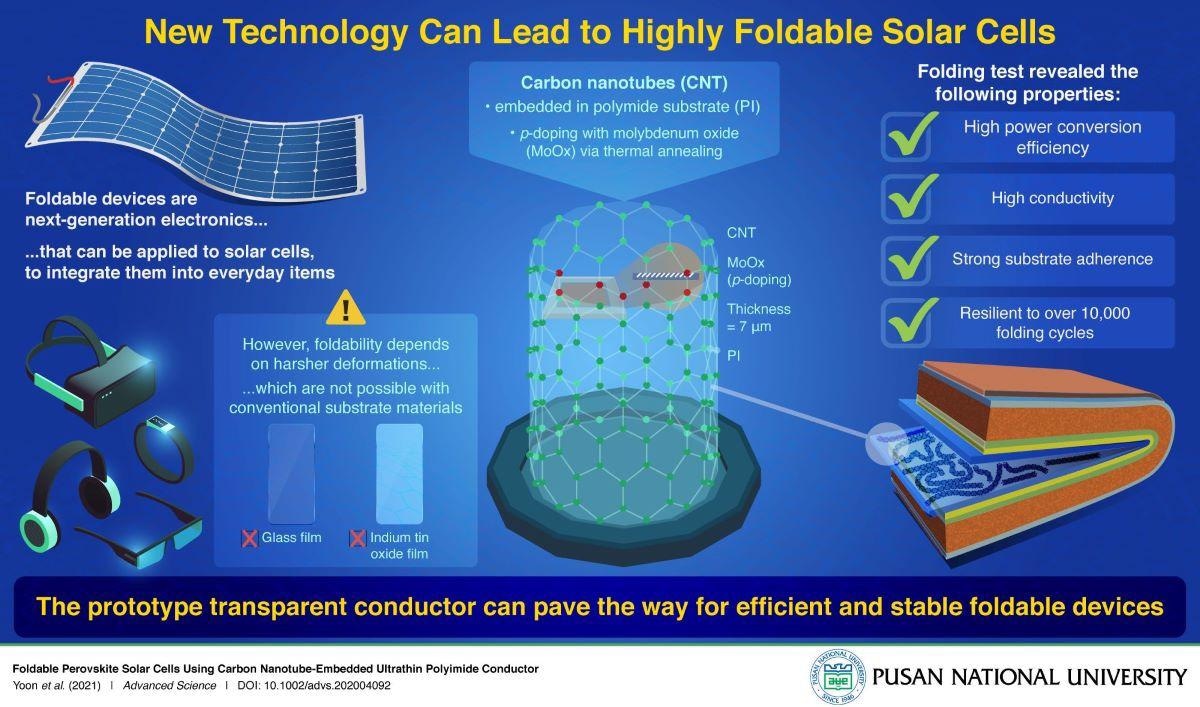Feb 12 2021
Studies on foldable electronics have gained huge momentum with the recent development of foldable mobile phone screens. A specifically valuable application of foldable technology is in solar panels.

Image Credit: Pusan National University.
Existing solar cells are limited to stiff, flat panels, which are hard to store in huge numbers and combine with day-to-day appliances, such as windows, phones, indoor devices, or vehicles. However, one issue has kept this valuable technology from gaining further momentum: for combining with these items, solar cells must be foldable, to frequently bend at will without breaking.
Conventional conducting materials utilized in solar cells do not have flexibility, which forms a huge hurdle in designing completely foldable cells.
The main prerequisite for an effective foldable conductor is the potential to endure the pressure of bending inside a very small radius while retaining its integrity and other preferable properties. Simply put, a thin, transparent, resilient, and flexible conductor material is required.
Unlike merely flexible electronics, foldable devices are subject to much harsher deformations, with folding radii as small as 0.5 mm. This is not possible with conventional ultra-thin glass substrates and metal oxide transparent conductors, which can be made flexible but never fully foldable.”
Il Jeon, Professor, Pusan National University
Luckily, an international research team, which included Professor Jeon, has discovered a solution, reported in a study published in the Advanced Science journal. They have determined a potential candidate as the solution to all of these needs: single-walled carbon nanotube (SWNT) films, due to their mechanical resilience and high transparency.
The only issue here is that SWNTs find it hard to stick to the surface of the substrate upon applying force (like bending) and need chemical doping. To overcome this issue, the researchers interspersed the conducting layer into a polyimide (PI) substrate, thereby filling the void spaces present in the nanotubes.
Moreover, they “doped” the ensuing material to enhance its conductivity to guarantee optimum performance. The addition of small impurities (in this instance, withdrawn electrons to molybdenum oxide) to the SWNT-PI nanocomposite layer considerably reduces the energy required for electrons to move throughout the structure, thus enabling more charge to be produced for a specified amount of current.
The resultant prototype substantially exceeded the expectations of the team. The composite film was just 7 mm thick but displayed remarkable resistance to bending, nearly 80% transparency, and a 15.2% power conversion efficiency, the maximum values ever achieved in solar cells by using carbon nanotube conductors.
The obtained results are some of the best among those reported thus far for flexible solar cells, both in terms efficiency and mechanical stability.
Il Jeon, Professor, Pusan National University
Thanks to this innovative advancement in solar harvesting technology, one can visualize what next-generation solar panels will look like.
Journal Reference
Yoon, J., et al. (2021) Foldable Perovskite Solar Cells Using Carbon Nanotube‐Embedded Ultrathin Polyimide Conductor. Advanced Science. doi.org/10.1002/advs.202004092.
Source: https://www.pusan.ac.kr/eng/